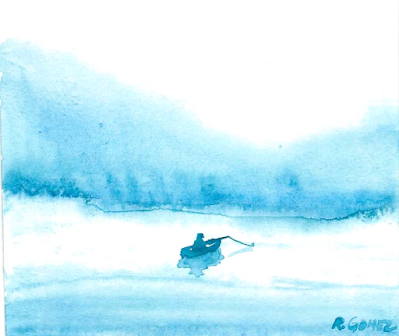by Marci Whitehurst
Perhaps you’ve pondered the origin of language, but have you ever stopped to think about the history of color?
Staring at a blue sky, it’s hard to think of color having a history, but in early civilizations there were artists, seeking to capture the colors of the world.
BLUE, by Nana Ekua Brew-Hammond, explores the earliest moments of this primary color beginning with:
“The color blue is all around us.Have you ever wondered where it comes from?
It’s in the sky, but you can’t touch it.It’s in the sea, but when you cup it,it disappears.”
The history of the color began as early as 4500 BC, as evidenced by diggers who found blue rocks called lapis lazuli in Egyptian civilizations. Artists have created the color for centuries to use for special reasons—even the drapes in King Solomon’s temple. The color spans time and cultures and connects us all to not only the visual aspects, but also the feeling of blue. The emotions behind this color are also part of the history of Blue: we use the color to describe feelings using phrases like “I’m blue.” The rich history of this basic color goes beyond what we see every day.
READ:
Blue: A History of the Color as Deep as the Sea and as Wide as the Sky by Nana Ekua Brew-Hammond, illustrated by Daniel Minter
DISCUSS:
- What is your earliest memory of the color blue?
- What is your favorite color? Do you know why?
- What emotion do you feel when you see the color blue?
- Have you ever felt “blue”? What makes you feel better?
DO:
- Play “I Spy.” How many different things can you find that are the color blue?
- Go for a walk: where do you see the color blue outside other than the sky?
- Look up the history of your favorite color. When was it first man-made?
- Create a work of art using only shades of blue. You can use crayons, markers, paint, or a mixture of the three. Here's a tutorial for a blue watercolor landscape. See Rebecca's example below!
- Make a batch of blue play dough. Here's a simple recipe:
- Mix together 2 1/2 cups flour, 1 cup salt, and 1 teaspoon alum.
- In a separate bowl, mix 1 cup hot water and 1/2 cup oil.
- Mix the wet and dry ingredients together. Knead it to make a workable dough. As you're kneading the dough, add a pouch of blue Jello and work it in completely.
- Optional: add sequins or glitter for sparkly dough.
 |
| Rebecca's blue watercolor painting |



Comments